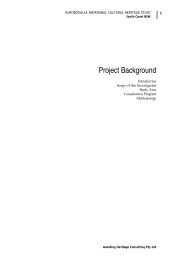Eurobodalla Integrated Water Cycle Management Strategy
Eurobodalla Integrated Water Cycle Management Strategy
Eurobodalla Integrated Water Cycle Management Strategy
You also want an ePaper? Increase the reach of your titles
YUMPU automatically turns print PDFs into web optimized ePapers that Google loves.
FACT SHEET 2<br />
Planning Controls<br />
<strong>Eurobodalla</strong> <strong>Integrated</strong> <strong>Water</strong> <strong>Cycle</strong> <strong>Management</strong> <strong>Strategy</strong><br />
What are Planning Controls?<br />
Planning controls are legal instruments made under the Environmental Planning and<br />
Assessment Act 1979. They consist of local environmental plans (LEPs), regional<br />
environmental plans (REPs) and state environmental planning policies (SEPPs), which<br />
describe the current planning status and/or future developments of an area. LEPs are made by<br />
Council and dictate the types of developments allowed in each zone of a local government<br />
area.<br />
Development control plans (DCPs) are detailed guidelines that illustrate the controls that apply<br />
to a particular type of development or in a particular area. A DCP refines or supplements a<br />
REP or LEP.<br />
Urban water needs are dictated largely by local environmental planning, urban subdivision<br />
designs, and building designs, before the householder exercises choice.<br />
Council has the opportunity to play an important role in reducing future water consumption.<br />
This may be achieved through the use of planning controls, for example, that mandate the<br />
installation of water efficient appliances and water sensitive gardens, through its role as the<br />
determining authority for the majority of developments in the area.<br />
Over the last decade many councils have developed planning frameworks to reduce water<br />
consumption and to minimise stormwater runoff. Incorporated into this framework is the water<br />
sensitive urban design concept (fact sheet 1).<br />
Examples<br />
<strong>Eurobodalla</strong> Shire Council, through its Residential Design and Development Guidelines DCP<br />
and building codes, encourages the use of energy efficient fixtures and appliances. This<br />
program also indirectly encourages improved water use efficiency. Installing AAA rated shower<br />
roses, for example, saves hot water and therefore energy for heating. However, the present<br />
focus of the DCP is energy abatement and does not explicitly mention water conservation.<br />
Benefits<br />
Provides a strong conservation message to the community<br />
Reduces pollutant loads of receiving waters<br />
Reducing or delaying large infrastructure costs both up and downstream (e.g. size of mains<br />
and STP augmentations)<br />
Allows Council to exercise discretion on which end uses and areas of the water cycle to<br />
mandate<br />
Allows Council to set controls before market forces influence customer’s purchasing decisions<br />
of appliances<br />
Increases environmental benefits through better planning, water and energy use<br />
Reduced greenhouse gas emission<br />
17

















